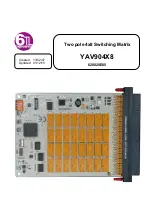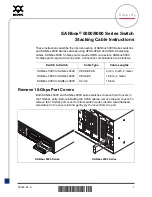
example, a network’s data transfer rate is measured in
bits per second (bps). Throughput is a measure of
performance. It is also measured in Kbps or Mbps. See
also bandwidth.
topology. In Fibre Channel technology, the
configuration of the Fibre Channel network and the
resulting communication paths allowed. There are three
possible topologies: point-to-point, which allows a direct
link between two communication ports; switched fabric,
which allows multiple node ports (N_ports) to be linked
to a switch by fabric ports (F_ports); and arbitrated loop,
which allows multiple node loop ports (NL_ports) to be
connected in a loop.
translative mode. A mode in which private devices
can communicate with public devices across the fabric.
transmission character. A 10-bit character encoded
according to the rules of the 8B/10B algorithm.
Transmission Control Protocol (TCP). A
communication protocol used in the Internet and in any
network that follows the Internet Engineering Task Force
(IETF) standards for internetwork protocol. Transmission
Control Protocol (TCP) provides a reliable host-to-host
protocol between hosts in packed-switched
communication networks and in interconnected systems
of such networks. It uses the Internet Protocol (IP) as
the underlying protocol.
transmission word. A group of four transmission
characters.
trap. In the Simple Network Management Protocol
(SNMP), a message sent by a managed node (agent
function) to a management station to report an
exception condition. See also simple network
management protocol.
trunking ports. Ports that are in the trunking group.
tunneling. To treat a transport network as though it
were a single communication link or local area network
(LAN).
U. The unit of measure for rack-mounted equipment.
UDP. See User Datagram Protocol.
ULP. See upper-layer protocol.
ULP_TOV. See upper-layer timeout value.
unicast. Transmission of data to a single destination.
See also broadcast and multicast.
universal port (U_port). A switch port that can
operate as a generic port (G_port), expansion port
(E_port), fabric port (F_port), or fabric loop port
(FL_port). A port is defined as a U_port when it is not
connected or has not yet assumed a specific function in
the fabric.
U_port. See universal port.
upper-layer protocol (ULP). A protocol used on a
Fibre Channel network at or above the FC-4 level.
upper-layer timeout value (ULP_TOV). The minimum
time that a SCSI ULP process waits for SCSI status
before initiating ULP recovery.
User Datagram Protocol (UDP). In the Internet suite
of protocols, a protocol that provides unreliable,
connectionless datagram service. It enables an
application program on one machine or process to send
a datagram to an application program on another
machine or process. UDP uses the Internet Protocol
(IP) to deliver datagrams.
WAN. See wide area network.
well-known address. An address used to uniquely
identify a particular node in the network to establish
connections between nodes.
wide area network (WAN). A network that provides
communication services to a geographic area larger
than that served by a local area network or a
metropolitan network, and that may use or provide
public communications facilities. (T)
workstation. A powerful, single-user microcomputer,
usually with a high-resolution display. Workstations are
often used in conjunction with networked applications in
which programs run on the workstation using data that
resides on a server, which is connected to the
workstation by a network.
worldwide name (WWN). A unique identifier for a
switch on local and global networks.
World Wide Web (WWW). A network of servers that
contain programs and files. Many of the files contain
hypertext links to other documents available through the
network.
WWN. See worldwide name.
WWW. See World Wide Web.
zone. A collection of Fibre Channel node ports
(N_ports) or node loop ports (NL_ports) (that is, device
ports) that are permitted to communicate with each
other using the fabric. Any two N_ports or NL_ports that
are not members of at least one common zone are not
permitted to communicate using the fabric. Zone
membership can be specified by: 1) port location on a
switch (that is, domain_ID and port number); or, 2) the
N_port_name of the device; or, 3) the address identifier
of the device; or, 4) the node name of the device.
Well-known addresses are implicitly included in every
zone. See also zoning.
zone alias. An alias for a set of port numbers or
worldwide names (WWNs). Zone aliases can be used to
70
IBM TotalStorage SAN Switch: 3534 Model F08 Installation and User’s Guide
Summary of Contents for TotalStorage 3534-F08
Page 2: ......
Page 3: ...IBM TotalStorage SAN Switch 3534 Model F08 Installation and User s Guide GC26 7559 00...
Page 8: ...vi IBM TotalStorage SAN Switch 3534 Model F08 Installation and User s Guide...
Page 10: ...viii IBM TotalStorage SAN Switch 3534 Model F08 Installation and User s Guide...
Page 12: ...x IBM TotalStorage SAN Switch 3534 Model F08 Installation and User s Guide...
Page 18: ...xvi IBM TotalStorage SAN Switch 3534 Model F08 Installation and User s Guide...
Page 22: ...xx IBM TotalStorage SAN Switch 3534 Model F08 Installation and User s Guide...
Page 62: ...40 IBM TotalStorage SAN Switch 3534 Model F08 Installation and User s Guide...
Page 82: ...60 IBM TotalStorage SAN Switch 3534 Model F08 Installation and User s Guide...
Page 94: ...72 IBM TotalStorage SAN Switch 3534 Model F08 Installation and User s Guide...
Page 100: ...78 IBM TotalStorage SAN Switch 3534 Model F08 Installation and User s Guide...
Page 103: ......
Page 104: ...Part Number 17P7301 Printed in U S A GC26 7559 00 1P P N 17P7301...
Page 105: ...Spine information IBM TotalStorage SAN Switch 3534 Model F08 Installation and User s Guide...














































